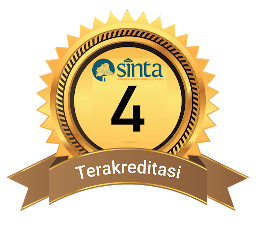Development of Chemistry Learning Module Based a Simple Experimental on The Rate of Reaction Subject XI IPA Class of SMAN 1 Pringgarata
DOI:
10.29303/cep.v7i2.4805Published:
2024-12-04Issue:
Vol. 7 No. 2 (2024): Edisi NovemberKeywords:
Development, Chemistry Learning Module, Simple ExperimentalArticles
Downloads
How to Cite
Abstract
This research is a Research and Development type with the aims to determine: 1) The characteristic of chemistry learning module based on simple experimental on the rate of reaction subject, and 2) The feasibility and practicality of the chemistry learning module based on simple experimental on the rate of reaction subject. The method used in this research is the 4D (Define, Design, Development, and Dissemination). This research was carried out until the development stage. The population were XI IPA students of SMAN 1 Pringgarata of the academic year 2021/2022. While the sample in this study were55 student who were taken randomly with stratified (stratified random sampling). The result showed that the value of validity obtained using the Aiken index (V) was 0,78 in the category of valid. Meanwhile, practicality of the chemistry learning module developed can be seen from the student responses of 84% in the category of high practicality. Based on the data, it can be conclude that the developed chemistry learning module based a simple experimental on the rate of reaction subject is feasible and practical so that it can be used in the learning process.
References
Al Azka, H. H., Setyawati, R. D., & Albab, I. U. (2019). Pengembangan Modul Pembelajaran. Imajiner: Jurnal Matematika dan Pendidikan Matematika,1(5), 224-236.
Damayanti, N. K. A., Maryam, S., & Subagia, I. W. (2019). Analisis pelaksanaan praktikum kimia. Jurnal Pendidikan Kimia Undiksha, 3(2), 52-60.
Duwiri, Y. I. & Siregar, T. (2016). Pengembangan Modul Kimia Topik Sifat Larutan Asam Basa Kelas XI IPA dalam Meningkatkan Kemampuan Belajar Siswa di SMA Negeri 1 Teminabuan Kabupaten Sorong Selatan. Jurnal Ilmu Pendidikan Indonesia, 4 (1), ISSN 2338-3402, hlm. 54-65.
Esmiyati, Haryani, Sri., & Purwantoyo, E. (2013). Pengembangan Modul IPA Terpadu Bervisi SETS (Science, Environment, Technology, and Society) Pada Tema Ekosistem. Unnes Science Education Jurnal, 2 (1), ISSN 2252-6609, hlm. 180-187.
Hadisaputra, S., Savalas, L. R. T., & Hamdiani, S. (2017). Praktikum kimia berbasis kimia komputasi untuk sekolah menengah atas. Jurnal Pijar Mipa, 12(1).
Haryanti, J. (2020). Desain dan Uji Coba E-Handout Berbasis Literasi Sains Siswa pada Materi Laju Reaksi (Doctoral dissertation, Universitas Islam Negeri Sultan Syarif Kasim Riau).
Latifah, S., Sugiharto, S., & Saputro, A. N. C. (2014). Studi Komparasi Penggunaan Praktikum dan Demonstrasi pada Metode Problem Solving Terhadap Prestasi Belajar Siswa Materi Hidrolisis Garam Kelas XI Ilmu Alam SMA Al Islam 1 Surakarta Tahun Pelajaran 2010/2011. Jurnal Pendidikan Kimia, 3(3), 111-120.
Nurkholik, M., & Yonata, B. (2020).
Implementasi Model Pembelajaran Inkuiri Untuk Melatihkan High Order Thinking Skills Peserta Didik Pada Materi Laju Reaksi Kelas XI IPA MAN 2 Gresik. Unesa Journal of Chemical Education, 9(1), 158-164.
Retnawati, H. (2016). Validitas Reliabilitas dan Karakteristik (Panduan Untuk Peneliti, Mahasiswa, dan Psikometrian). Yogyakarta: Parama Publishing.
Riduwan. (2009). Metode dan Teknik Menyusun Tesis. Bandung: Alfabeta.
Sanjaya, W. (2015). Perencanaan dan desain sistem pembelajaran. Kencana.
Sari, N. S., Farida, N., & Rahmawati, D. (2020). Pengembangan Modul Berbasis Discovery Learning Untuk Melatih Literasi Matematika. EMTEKA: Jurnal Pendidikan Matematika, 1(1), 11-23.
Sari, F. K., Farida, F., & Syazali, M. (2016). Pengembangan Media Pembelajaran (Modul) berbantuan Geogebra Pokok Bahasan Turunan. Al-Jabar: Jurnal Pendidikan Matematika, 7(2), 135-152.
Sawitri, D. W. (2014). Pengembangan modul keanekaragaman hayati berbasis pendekatan saintifik untuk siswa kelas X SMA. Berkala Ilmiah Pendidikan Biologi (BioEdu), 3(3).
Suryani, D. I., Suhery, T., & Ibrahim, A. R. (2014). Pengembangan modul kimia reaksi reduksi oksidasi kelas X SMA. Jurnal Penelitian Pendidikan Kimia: Kajian Hasil Penelitian Pendidikan Kimia, 1(1), 18-28.
Trianto. (2011). Mendesain Model Pembelajaran Inovatif Progresif, Konsep, Landasan, dan Implementasinya pada Kurikulum Tingkat Satuan Pendidikan (KTSP). Jakarta Kencana.
Ulya, H., Rudibyani, R. B., & Efkar, T. (2018). Pengembangan modul kimia berbasis problem solving pada materi asam basa Arrhenius. Jurnal Pendidikan Dan Pembelajaran Kimia, 7(1), 129-141.
Author Biography
Surya Anjani, Pendidikan Kimia, Universitas Mataram
License
Copyright (c) 2024 Surya Anjani Anjani, Eka Junaidi Junaidi, Jeckson Siahaan Siahaan

This work is licensed under a Creative Commons Attribution-ShareAlike 4.0 International License.
Authors who publish with Chemistry Education Practice agree to the following terms:
- Authors retain copyright and grant the journal right of first publication with the work simultaneously licensed under a Creative Commons Attribution License 4.0 International License (CC-BY-SA License). This license allows authors to use all articles, data sets, graphics, and appendices in data mining applications, search engines, web sites, blogs, and other platforms by providing an appropriate reference. The journal allows the author(s) to hold the copyright without restrictions and will retain publishing rights without restrictions.
- Authors are able to enter into separate, additional contractual arrangements for the non-exclusive distribution of the journal's published version of the work (e.g., post it to an institutional repository or publish it in a book), with an acknowledgement of its initial publication in Chemistry Education Practice.
- Authors are permitted and encouraged to post their work online (e.g., in institutional repositories or on their website) prior to and during the submission process, as it can lead to productive exchanges, as well as earlier and greater citation of published work (See The Effect of Open Access).






